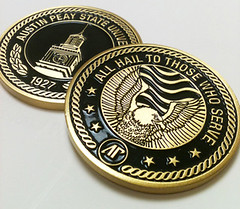
About UsThe Numismatic Bibliomania Society is a non-profit organization promoting numismatic literature. For more information please see our web site at coinbooks.org SubscriptionsThose wishing to become new E-Sylum subscribers (or wishing to Unsubscribe) can go to the following web page link MembershipThere is a membership application available on the web site Membership Application To join, print the application and return it with your check to the address printed on the application. Membership is only $15 to addresses in the U.S., $20 for First Class mail, and $25 elsewhere. For those without web access, write to: David M. Sundman, Secretary/TreasurerNumismatic Bibliomania
Society AsylumFor Asylum mailing address changes and other membership questions, contact David at this email address: dsundman@LittletonCoin.com SubmissionsTo submit items for publication in The E-Sylum, just Reply to this message, or write to the Editor at this address: whomren@coinlibrary.com
BUY THE BOOK BEFORE THE COINYou won't regret it! |
- WAYNE'S WORDS: THE E-SYLUM DECEMBER 18, 2011
- KOLBE & FANNING'S ONLINE BIDDING AND LOT VIEWING OPTIONS
- SKLOW MAIL BID SALE # 15 CATALOG AVAILABLE
- NEW BOOK: STANDARD CATALOG OF WORLD COINS 1601-1700, 5TH EDITION
- SURVEY: INSTITUTIONAL NUMISMATIC LIBRARIES OF THE WORLD
- READER THOUGHTS ON JOHN ESHBACH
- QUIZ ANSWER: THE AMERICAN NUMISMATIST
- HOW VALUBLE IS THE COLLECTION FOUND IN THE PASSAU LIBRARY?
- NOTES FROM E-SYLUM READERS: DECEMBER 18, 2011
- MORE ON IRRADIATED DIMES
- DOLLAR COIN PRODUCTION VIRTUALLY HALTED
- SOME IN CONGRESS CONSIDER ELIMINATING THE PAPER DOLLAR
- DICK JOHNSON ON STEEL COIN LEGISLATION
- KLAN KREED COIN
- KOLBE-FANNING 2012 NEW YORK SALE LOTS: NEWLIN, PERKINS
- THE 1766 PATTERN ROUBLE OF CATHERINE II
- VIKING COIN FIND IN LANCASHIRE, ENGLAND
- DAYTONA COUNCILMAN SPENDS REAL FAKE CASH
- MORE ON THE OCCUPY MOVEMENT DOLLAR BILL
- THE CIA BAY OF PIGS COUNTERFEITS
- U.S. HALF DIME CIRCULATION IN CUBA
- BRASHER DOUBLOON SELLS TO HEDGE FUND
- HOW TO BECOME A BIBLIOMANIAC
- THE LIBRARY THAT LOOKS LIKE A BOOKSHELF
- FEATURED WEB PAGE: WHICH CHARPENTIER MADE THAT MEDAL?
WAYNE'S WORDS: THE E-SYLUM DECEMBER 18, 2011

In our Christmas Eve issue December 24, 1998, I wrote:
Your scribe is proud to report that his son Christopher Knobel Homren was born at 1:54pm Friday, December 18th, weighing in at 8 lbs, 10oz, 21 inches. Mom and baby are fine and resting at home for the holidays. Dad's still kind of bewildered and thinking, "please kid, get your own books to color in..."
Well, today my firstborn turned 13 and he's nearly as tall as me. Playing basketball this morning he repeatedly smoked me, at times just taking the ball out of my hands as I tried hopelessly to make a shot past him. All I could do is laugh. Mom calls him "Sasquatch". This issue is dedicated to a fine (and tall) straight-A student, Christopher. You've made Dad proud. Happy birthday!
Among our new subscribers this week are Gaylord Allen, Chris Vandall and Burt Clark, courtesy of Bob Neale, Barbara Bonous-Smit, M. Savinelli, and Gil Menendez,. Welcome aboard! We have 1,483 email subscribers, plus 167 followers on Facebook.
This week we open with updated from two numismatic booksellers, word of one new numismatic book and a survey of institutional numismatic libraries.
Other topics this week include The American Numismatist periodicals, Irradiated Dimes, politics and U.S. coins and paper money, and U.S. Half Dime circulation in Cuba.
To learn more about Obsessive Hoarding Disorder and How to Become a Bibliomaniac, the Klan Kreed Coin, the CIA's Bay of Pigs Cuban counterfeits, and the Library That Looks Like a Bookshelf, read on. Have a great week, everyone!
Wayne Homren
Numismatic Bibliomania Society
KOLBE & FANNING'S ONLINE BIDDING AND LOT VIEWING OPTIONS
 Kolbe & Fanning Numismatic Booksellers will be holding their 2012 New York Book Sale at the Waldorf-Astoria Hotel in New York City on Saturday afternoon, January 7. As a Kolbe & Fanning regular, you may have already received a copy of the printed catalogue, but we wanted to bring to your attention some additional news.
Kolbe & Fanning Numismatic Booksellers will be holding their 2012 New York Book Sale at the Waldorf-Astoria Hotel in New York City on Saturday afternoon, January 7. As a Kolbe & Fanning regular, you may have already received a copy of the printed catalogue, but we wanted to bring to your attention some additional news.
As in the past, a PDF version of the catalogue is available from the Kolbe & Fanning website at www.numislit.com. The PDF is handy for searching for items by keywords or when your copy of the catalogue is not conveniently at hand.
For the first time, we will be offering free live internet bidding for this auction via the-saleroom.com. Also, every lot is illustrated in this version of the catalogue and the illustrations can easily be enlarged. Through the-saleroom.com, you may register to bid in the auction, and you may leave absentee bids to be executed by the-saleroom.com staff who will attend the auction. In addition, you may watch the auction take place in real time and directly participate in the live event via your computer. While we have offered this service before, this year we are offering it at no additional cost to bidders. The usual terms apply, but no additional fees will be incurred by bidders who participate through the-saleroom.com.
To register to participate in the online auction, go to the-saleroom.com and create an account (a credit card will be necessary to bid in the sale, though other forms of payment may be used). You will find Kolbe & Fanning listed in the directory of auction houses. The online catalogue is easy to navigate and, as previously mentioned, every lot is illustrated.
The following link should lead directly to the catalogue:
www.the-saleroom.com/en-gb/auction-catalogues/george-frederick-kolbe
/catalogue-id-2852516
SKLOW MAIL BID SALE # 15 CATALOG AVAILABLE
 DAVID SKLOW â" FINE NUMISMATIC LITERATURE
DAVID SKLOW â" FINE NUMISMATIC LITERATURE
MAIL BID SALE # 15 CLOSING FEBRUARY 11, 2012
IS NOW AVAILABLE ONLINE AT OUR WEB SITE.
- Handbook of U.S. Coins, by Yeoman, Hewitt and Green, several first editions 1942.
- Handbook of U. S. Coins, by Yeoman, Hewitt and Green, editions 2nd through 13th including over date/overprint fourth and ninth editions.
- Rarely seen autographed fifth edition Handbook of U.S. Coins, signed by Author Charles E. Green.
- The large working worldwide library of a dedicated west coast dealer, some very nice surprises!
- 1908 first Membership Directory of the American Numismatic Association.
- 1913 second Membership Directory of the American Numismatic Association
- 1917 third Membership Directory of the American Numismatic Association.
- Unique 1883 edition of Andrews, used and annotated by B. Max Mehl as a mockup for his 1924 reprint of the work.
- Ken Lowe's deluxe hardbound 100th anniversary edition of Rare Coin Review Copy No. 23.
- Armand Champa's Numismatica Americana 1991 deluxe leather version, ex: Denis Mendelson.
- Unique prototype full green leather bound mockup by Alan Grace [1985] to exhibit his binding techniques to Champa.
- Frossard thirty-seventh sale Oct 1884, thick paper, plated.
- Frossard Monograph on 1793-1857 Cents & Half Cents, 1879, 9 plates.
- Frossard, Numisma 1983 reprint super deluxe half leather limited numbered edition No. 3 of 4.
- Gengerke's American Numismatic Auctions 1990 eighth edition super deluxe half leather limited numbered edition No. 3 of 6.
- Unique prototype hardbound textured green cloth black mockup for Gengerke's eighth edition.
- Rare three volume set of bound auction catalogs one thru ten of The Money Tree limited numbered editions No. 1 of 7.
- Scott & Co. 40th sale catalog March 1882, plated.
- Smith, A. M. Coin Collectors of the U. S. Illustrated Guide, Volume one complete 1880-1881.
- Smith, Pete American Numismatic Biographies 1992, half leather super deluxe limited numbered edition No. 3 of 4.
- 1946 Davenport, Iowa Rare three piece convention medal set of the American Numismatic Association, Bronze, Silver & Gold medals in original box.
- 1975 Los Angeles, Ca. Rare American Numismatic Association convention medal in gold, limited numbered 74 of 161.
- 1976 New York, N.Y. Very Rare American Numismatic Association convention medal in gold, limited numbered 24 of 41.
- 1987 scarce Casa de Moneda de Mexico and American Numismatic Association 63mm five ounce silver medal.
- Unique mockup [by Fivaz & Stanton] working copy of the Cherrypickers guide second edition used to create the third edition.
- Run of Official ANA Convention medal sets all in original holders or boxes 1969 to 1992, 1996-1999.
- Never offered for sale before, the newly awarded ANA Presidential Award Medal 76mm. inscribed to Rollie Finner.
- The fabulous working library concerning Medals & Tokens of Russ Sears, containing many limited editions.
- A long run of Yeoman's Red Book 1947-2002, including many special editions.
- Convention and Banquet photographs of the American Numismatic Association, 1947, 1948, 1953, 1954, 1958, 1971.
- Dr. Josef Brettauer, Medicina in Nummis 1937 catalog.
- Keith Davignon, Contemporary Counterfeit Capped Bust Half Dollars, full leather super deluxe presentation limited numbered edition No. 5 of 5.
- Elder May 1920 sale of the Miller Collection, Rosa Americana's 1992 reprint with 28 plates produced from full size negatives, bound limited numbered edition No. 23 of 50.
- Fey & Oxman's The Top Morgan Dollar Varieties: The VAM Keys, full leather super deluxe limited numbered edition No. 50 of 100.
- R. W. Julian, Russian Silver Coinage 1796-1917, quarter leather super deluxe limited numbered edition No. 2 of 24.
- Glenn R. Peterson, The Ultimate Guide to Attributing Bust Half Dollars, quarter leather super deluxe limited numbered edition No. 3 of 40.
- Q. David Bowers bound set of the Niles Register 1811-1843
- Nicolas Tindal, 1751 A Summary of Mr. Rapin de Thoyras's History of England, [elephant folio].
CATALOGS AVAILABLE ON REQUEST
DAVID SKLOW â" FINE NUMISMATIC BOOKS
P.O. BOX 6321
COLORADO SPRINGS, CO 80934
TEL: (719) 302-5686
FAX: (719) 302-4933
finenumismaticbooks@aol.com
www.finenumismaticbooks.com
NEW BOOK: STANDARD CATALOG OF WORLD COINS 1601-1700, 5TH EDITION
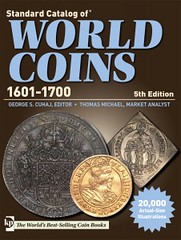 The Standard Catalog of World Coins 1601-1700 is now available from Krause Publications.
The Standard Catalog of World Coins 1601-1700 is now available from Krause Publications.
Edited by George Cuhaj and Tom Michael, this fifth edition presents some of the fastest-rising retail values for world coins. Economic factors have continued to drive collector interest and push prices for these classic coins higher and higher.
The fifth edition Standard Catalog of World Coins 1601-1700 features:
- Updated values for all coin listings
- Substantial changes in value for most European coinage
- Additional listings and value changes for German states
- Expanded listings for Italian states and the Netherlands
- Complete revisions for India, Iran and Iraq
- Full value updates for Austria, Hungary and Transylvania
- Special auction quotes for many rare coinage types
With information compiled by over 200 experts worldwide, this book features collector coins, sets, trial strikes, patterns, token issues, etc. with nearly 300,000 accurate coin prices in up to 5 grades and 22,500 quality images including hundreds of improved images for easy identification.
For more information visit
www.sellcoinbooks.com/world-coin-books/standard-catalog-of-world-coins-1601-1700
.
SURVEY: INSTITUTIONAL NUMISMATIC LIBRARIES OF THE WORLD
I am conducting a study on numismatic libraries and I am writing to ask your help. The study is part of an effort to learn more about numismatic libraries and to create a directory of numismatic libraries in the United States and around the world, since no directory currently exists. I am sure many interested in numismatics will find such a directory of great value, including numismatists, numismatic scholars, historians, archaeologists, coin collectors and dealers, librarians, other researchers, and the general public. I would appreciate receiving your input so that the result will assist me in the creation of the Directory of Numismatic Libraries and truly reflect characteristics of numismatic libraries.
Your answers to this questionnaire are completely confidential. Concerning the survey procedures, I am using SurveyMonkey for the purpose of collecting data for this survey. Of course, participation in this survey is strictly voluntary. However, you can help me very much by taking a few minutes to answer the survey available at: www.surveymonkey.com/s.aspx?sm=QWeVlvrCEhfxmyeG8J_2fyCw_3d_3d .
Please feel free to send any additional information about your library, such as a brief history, for inclusion in the directory. Any submission may be edited by the author. Submission of this information is voluntary and will not impact in any way the outcomes of this research.
This study does not present any risks and you will not be compensated for participating. You may skip any questions you don't want to answer and you may stop answering questions at any time without penalty. I intend to retain your responses, and any information you provide will not be destroyed.
After the study is completed, a summary of the demographic and characteristic findings will also be published as an article. The article will also contain an appendix with a geographical listing of only the names of numismatic libraries.
You will have an opportunity to check the information about your library in the directory before it is published. You will also receive a copy of the article before it is published. Before the results are published as a directory or article, you will be free to make any changes/correction to your library's entry or request deletion of your library's entry in the Directory of Numismatic Libraries and in the appendix of the article.
If you have any questions or comment about this study, I would be happy to talk with you. You can call me at (718) 281-5010 or e-mail me at: BBonoussmit@qcc.cuny.edu or Dr. Paul Marchese at (718) 631-6690 or via e-mail at: pmarchese@qcc.cuny.edu.
Thank you very much for helping me with this important study. Your contribution is greatly appreciated.
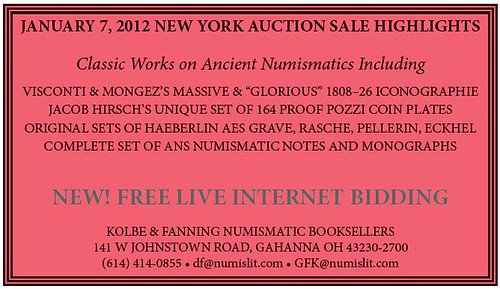
READER THOUGHTS ON JOHN ESHBACH
Greg Heim writes:
Lisa and I were saddened to hear of the passing of John Eshbach. It was a pleasure working with him when we were judging exhibits actively at the summer ANA Conventions from 1994-2004. I am sure that is Pennsylvania-area friends and his family are going to miss him as well
Howard A. Daniel III writes:
I was greatly saddened to read about the passing of John Eshbach. He was one of my many mentors in numismatics.
It was often after I posed a numismatic question in The E-Sylum or elsewhere that I would be contacted by John with an answer or someone else to talk to for the answer. He was a strong silent type of man, so when he spoke, he had something of importance to say and was not just talking to hear himself. He was the ultimate gentleman and I will miss talking with him at future shows, but I think he will be there with us in spirit.
I was saddened to learn of the death of John Eshbach, though not too surprised. He looked frail when I saw him at the Pittsburgh ANA Convention. John was the very definition of someone who contributed endlessly to the hobby, and his passing is a real loss.
Among the many tributes to John that I've seen there's been no mention of one particularly interesting facet of his hobby activity. For a time he manufactured and sold superb coin display holders under the brand name Showcase by Eshbach. I was a customer for these holders during the few years in which they were available, and I grew to admire them for both their attractiveness and numismatic accuracy.

The Showcase is a rigid display consisting of a screw-assembly stainless steel frame and two panels of glass. Underneath the glass is a foam plastic mounting with pre-punched openings for coins, and between this insert and the glass is a clear, printed sheet. The plugs for the openings were left in place until a coin was acquired, at which time it lifted out easily. This feature eliminated glaring holes in the collection while it was growing. The Showcase line included many holders for date-and-mint sets of most USA and Canadian coins, as well as type sets for some other countries. These made every collection look like a museum exhibit, and they also provided pretty good protection for the coins.
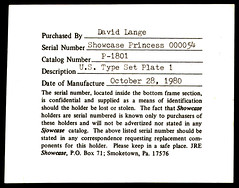 In 1980 I bought the three Showcase holders which comprised a complete USA type collection, less the gold issues. These made such a beautiful display that I was asked by the Director of the Old San Francisco Mint Museum to loan my type set for display there, and we were in the midst of making these arrangements when the museum abruptly closed in 1993. I'm attaching a scan of the first holder, Plate 1. The foam plugs remain in place for the few coins I was lacking, though it's hard to see them in the scan. I'm also attaching a scan of the certificate which accompanied each holder. Somewhere I have the Showcase printed catalog, but I couldn't find it without tearing up half the house.
In 1980 I bought the three Showcase holders which comprised a complete USA type collection, less the gold issues. These made such a beautiful display that I was asked by the Director of the Old San Francisco Mint Museum to loan my type set for display there, and we were in the midst of making these arrangements when the museum abruptly closed in 1993. I'm attaching a scan of the first holder, Plate 1. The foam plugs remain in place for the few coins I was lacking, though it's hard to see them in the scan. I'm also attaching a scan of the certificate which accompanied each holder. Somewhere I have the Showcase printed catalog, but I couldn't find it without tearing up half the house.
When I attempted to order more Showcase holders from John in the late 1980s, he said that the whole enterprise had been discontinued. I pressed him as to why he would stop selling such a fine product, and he muttered something about a lawsuit. I gathered that someone had been injured, perhaps by broken glass, but I could see that it was a sore subject he didn't want to discuss. I brought up the matter again a few years later, but it still rankled him, and he never did give me the whole story.
My Showcase type set holders are retired now, but I still consider them an important, albeit peripheral, part of my coin album collection. They also stand as a fine tribute to a remarkable individual.
To read the earlier E-Sylum article, see: JOHN R. ESHBACH: 1921-2011 (www.coinbooks.org/esylum_v14n51a05.html)
QUIZ ANSWER: THE AMERICAN NUMISMATIST
In last week's item about Paul Hollis' book American Numismatist I asked:
What other work of numismatic literature has the title American Numismatist ?
George Kolbe writes:
Isn't there an inaccuracy in the above query dealing with pluralization, to say nothing of the absence of the most common word in the English language (used four times in the present sentence alone, or six if you include the parenthesized text)? ;-)
Pete Smith writes:
Dr. George Heath published a newsletter with the title, "The American Numismatist." He quickly shortened this to just "The Numismatist."
Several years ago Gail Baker recruited me as a judge for one of her quiz games at the ANA. This was shortly after the ANA journal was shortened to Numismatist. There was a question about The American Numismatist. I announced that Heath changed the name to appeal to a younger demographic. A few people got the joke.
David Gladfelter writes:
Why, that venerable periodical started up by Dr. George W. Heath in September-October, 1888, and now known as âThe Numismatistâ (formerly âNumismatistâ).
For extra credit: At the time there was another periodical with the title âThe American Numismatistâ, published in Paterson, N. J., but that one folded after a year or so.
Your question was almost too easy for us inmates.
American Numismatic Society librarian Elizabeth Hahn writes:
I was reading through the latest E-Sylum and always enjoy the little quizzes that you include at the end of some articles. When time permits, I like to try and answer them. Your latest question caught my eye, namely, you ask "What other work of numismatic literature has the title American Numismatist ?" A quick look at the ANS Library collections reveals that there were two early periodicals with that title. Both claim to be monthly publications for coin collectors, although one comes from Paterson, N.J., and the other from Saco, Maine. I've attached a photo of each for reference.
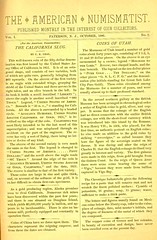
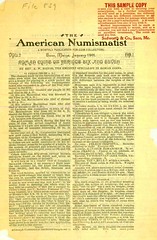
The American Numismatist, Patterson, NJ 1886
The American Numismatist, Saco, ME, 1901
To read the earlier E-Sylum article, see: NEW BOOK: AMERICAN NUMISMATIST (www.coinbooks.org/esylum_v14n51a03.html)
THE BOOK BAZARRE
HOW VALUBLE IS THE COLLECTION FOUND IN THE PASSAU LIBRARY?

Dating back from the years between the Roman Empire and Napoleon's rule, initial Internet research has revealed that the coins are worth a "low six-figure sum," Wennerhold said. Experts must now determine their exact value. The most valuable pieces will likely turn out to be decorative medals from the Baroque era, Wennerhold estimated.
The coins were probably forgotten because their value was underestimated by past library workers, Wennerhold told DAPD. "None of the current workers here knew that these coins existed," he said.
Library janitor Höls said she frequently goes to the fourth-floor archive -- where old furniture and even a stuffed crocodile are also stored -- in order to retrieve books for library patrons. The wooden box containing the coins was even periodically dusted by library employees without an inkling as to what was inside, Wennerhold said.
This week the Passau state library plans to release photos of each coin on its homepage. Next year they will be put on display as part of the library's anniversary celebration. Founded in 1612 as part of a Jesuit college, the library claims to be home to one of the oldest book collections in Germany.
 The international media loved that news! While cleaning a store room, a curious concierge opened a little wooden box and found a âtreasureâ composed of 172 coins and medals; its value was estimated generously at a six-digit figure in Euro.
The international media loved that news! While cleaning a store room, a curious concierge opened a little wooden box and found a âtreasureâ composed of 172 coins and medals; its value was estimated generously at a six-digit figure in Euro.
Now, the state library Passau publishes these coins in an exemplary manner on the Internet. And everybody is able to see for himself, what's the real value of these coins. Concerning the financial aspect the impression might be somehow disappointing. The original estimate is much too high. A five-digit figure is much more reasonable. (If the silver medals are tin, which could be indicated by the little dot of copper in the exergue, it will be even less.) But does that really matter? It is much more important, what kind of a collection has survived!
Before the secularization, the prince-bishopric Passau was one of the most powerful bishoprics in Germany. I am sure, that these coins can't be the showpieces from the collection of a prince-bishop, which were thought to be worth taking the risk of saving them from being confiscated! The state library Passau suggests it might have been the collection of a Jesuit, which served as teaching material. But is there any system in that collection?
We should not overlook the fact that the 18th century was the century of collectors. A happy coincidence has delivered us the collection of an average collector of the 18th century. Once there must have been tens of thousand collections like this. The true value of this collection is that it was not â" like all the other small collections â" dispersed and sold, but survived as collection!
If you want to see the coins of the collection, click here: www.staatliche-bibliothek-passau.de/staadi/muenzen.html .
To read the complete article, see: The Passau Treasure (www.coinsweekly.com/en/News/4?&id=920)
To read the earlier E-Sylum article, see: NOSEY LIBRARY JANITOR DISCOVERS ANCIENT COIN COLLECTION (www.coinbooks.org/esylum_v14n51a17.html)

NOTES FROM E-SYLUM READERS: DECEMBER 18, 2011
Obsessive Hoarding Disorder Gosia Fort writes:
The National Library of Medicine published the newest set of MeSH (Medical Subject Headings). The 2012 MeSH edition introduces a new obsessive-compulsive disorder - Obsessive Hoarding, which is defined as "Persistent difficulty discarding or parting with possessions, regardless of the value of these possessions. Epidemiological studies suggest that hoarding occurs in 2-5% of the population and can lead to substantial distress and disability, as well as serious public health consequences."
I wonder how many of us are on the border of being diagnosed with obsessive hoarding? :-) And, how do you like the name of the disorder?
Stamps As Legal Tender Under $5 Last week Ken Berger asked:
Does anybody know if the law, allowing postage and other stamps (presumably meaning revenue stamps) to be received for dues to the US not exceeding $5, has ever been repealed?
David Ganz writes:
"Fractional Money" as well as in Mitchell, "A History of Greenbacks" (1903).
Normal Wear and Tear on Polymer Banknotes Joe Boling writes:
On erasing a polymer banknote (and the comment that the treatment shown was not fair wear and tear) - recall last year when we were talking about polymer notes and I sent in a scan of a note that WAS virtually obliterated by fair wear and tear.
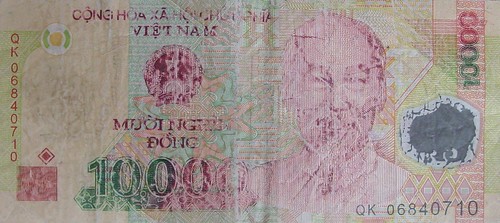
To read the earlier E-Sylum article, see: NOTES FROM E-SYLUM READERS: MARCH 14, 2010 (www.coinbooks.org/esylum_v13n11a12.html)
Joe Boling on Ads in Mainstream Publications and Other Topics Last week an E-Sylum reader asked:
Last Friday's New York Times (p. B-18) had a full-page ad from Bonhams promoting their Coins & Medals auction, 12/16, and their Meyer & Ebe ancient coin auction, 1/6. My particular question is 2-fold: does anyone have interest in the physical object of the ad? Does anyone have interest in the fact that they advertised that, in that medium?
Joe Boling writes:
I regularly clip ads that show images of US paper money that are illegal in their dimensions, as examples to show how editors and publishers ignore the rules and subject themselves to having an entire print run seized.
On other topics Joe adds:
The photo of Jeff Shevlin and Dick Johnson was captioned "Jeff took this photo of him and Dick at the ANA convention in Boston this past August." Off by a year.
And one more thing from Joe Boling:
University Issues Challenge Coin to Military Students An E-Sylumreader writes:
To read the complete article, see:
Austin Peay Graduating Military Students To Receive New Apsu Coin
(www.clarksvilleonline.com/2011/12/11/austin-peay-graduating
-military-students-to-receive-new-apsu-coin/)
Amos Publishing's Coin World Mergers David Gladfelter writes:
Actually, the Numismatic Scrapbook was sold to Amos Publishing Co., publisher of Coin World, in the 1960s. As Dave said, it was absorbed into Coin World in 1976. World Coins was another Amos Press periodical that I believe also became a Coin World section about the same time. These were editorial decisions apparently motivated by a belief that it would improve circulation and reduce costs.
Hispanic Society Coin Collection Sale Arthur Shippee forwarded a link to a short New York Timesarticle about the upcoming Sotheby's sale of the "Hispanic Society" coin collection, formerly housed at the American Numismatic Society.
A rare collection of almost 38,000 coins is expected to raise between $25 million and $35 million for the Hispanic Society of America, Sotheby's New York announced Thursday. The collection, assembled more than 100 years ago by Archer M. Huntington, the founder of the Hispanic Society, will be offered as a single lot in sealed bid auction beginning Thursday and ending next March.
Considered one of the most important collections outside of Spain related to Spanish history, it includes the â50 Excelentes,â a gold coin weighing nearly five ounces created in the 15th century, during the period of Christopher Columbus's voyages to the New World. The coin, according to a statement from Sotheby's, âis the largest gold coin from the 15th century that survives today.â In addition, there are more than 400 Roman gold coins that span the full history of Rome, including examples struck under Julius Caesar.
To read the complete article, see:
Hispanic Society Enlists Sotheby's to Auction Rare Collection of Coins
(artsbeat.blogs.nytimes.com/2011/12/15/hispanic-society-enlists
-sothebys-to-auction-rare-collection-of-coins/)
To read an earlier E-Sylum article, see: ARTICLE EXPLORES HISPANIC SOCIETY PLANS TO SELL HISTORIC COIN COLLECTION (www.coinbooks.org/esylum_v11n36a21.html)
Travel Writer Interviews Howard Berlin Numismatourist Howard Berlin writes:
I made the newspaper today. The writer asked for those who were retired and traveled and I replied. A photographer came out took a few pictures. I am mentioned on page 2 of the link below. Nothing about coins though...
To read the complete article, see: Uncharted territory: With planning, retirement is prime chance to travel (www.delawareonline.com/article/20111218/BUSINESS/112180319/Uncharted-territory)
THE BOOK BAZARRE
The Numismatic Book World Honors Eric Newmanon His 100th Birthday and for his 13 Numismatic Books
- Issued the Rittenhouse Society, 2011 -
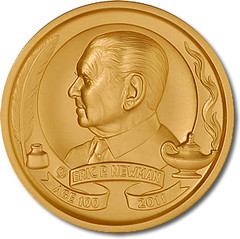
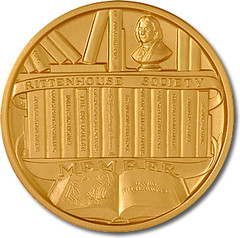
Full Proof Surface Silver medal in Exquisite detail. $245 postpaid
Set of both $285 postpaid. Personal checks preferred.
Dick Johnson 139 Torrington Drive Torrington, CT 06790
MORE ON IRRADIATED DIMES
Pascal Brock writes:
 In the spring of 1964 I visited Oak Ridge of a field trip with my physics class. We were allowed to make an irradiated dime with the machine that is pictured in the December 11 E-Sylum. I remember dropping the coin in the slot and watch it go through the machine. If Oak Ridge started making them in the 40's there should be a large number of these dimes in drawers somewhere. I would suspect mostly in the southeast.
In the spring of 1964 I visited Oak Ridge of a field trip with my physics class. We were allowed to make an irradiated dime with the machine that is pictured in the December 11 E-Sylum. I remember dropping the coin in the slot and watch it go through the machine. If Oak Ridge started making them in the 40's there should be a large number of these dimes in drawers somewhere. I would suspect mostly in the southeast.
Harold Levi writes:
Some time during the summer of 1952, Mom and Dad took myself and my sister to the Museum of Atomic Energy at Oak Ridge, Tenn. We lived in Jefferson City, Tenn. at that time while Dad attended Carson-Newman College. I was eleven at the time and vaguely remember the trip, but I do remember getting the irradiated dime. My sister, who passed-on several years ago, got one also. I have both souvenirs today but the dime is missing from one of the holders. I do not know which of these is mine or my late sister's. The remaining dime is dated 1944 and I believe the other was a Roosevelt.
This is the era when I started collecting coins. Mom was the one and only City Clerk at the time. Once a week the two city police officers would rob the one hundred or so parking meters and Mom and Dad would help count and roll the coins. I got a lot of pennies and a few dimes and nickels to start my collection. As the coins were counted, they would hold out the coins that looked old. I have often wondered how many early dates that looked new got away. Dad graduated in 1954 and we moved to Cosby, Tenn., moonshine capitol of East Tennessee, and that my friends is a whole 'nother story as Dad was a preacher.
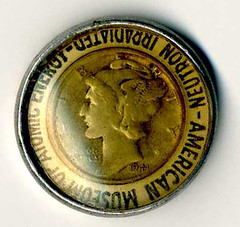

Harold Levi's Irradiated Dime and Empty Encasement
Bruce Perdue writes:
Regarding the "irradiated dimes" I have several in my encased collection. The 'winged liberty' one I have still has the plastic lens over the coin, many do not. There is no known census of the coin and they regularly sell on Ebay for $10 or so. there is also a blue plastic "irradiated" dime from the 1964 World's Fair. These are not as common and sell for around $15-$20.
The following is taken from the TAMS Journal, Vol.14, No. 1, February 1974.
"The Neutron Irradiated Dime, Atomic Energy Commission, New York World's Fair, 1964-1965" by Stephen P. Alpert, TAMS # 2134.
"The illustrated encased dime originated from the U.S. Atomic Energy Commission's exhibit in the Hall of Science, a pavilion in the Transportation Area of the 1964-1965 New York World's Fair.
To obtain this souvenir, the visitor deposited his dime into a very narrow machine with transparent sides. The dime rolled down a chute into the area where it was irradiated for a few seconds. It was then ejected via another chute, into a tray at the end of the machine. A Geiger counter nearby demonstrated the radioactivity of the silver dime. The attendant, wearing protective gloves, then snapped the dime in the plastic holder and handed you your souvenir.
The holder is blue plastic with white incuse lettering and design, and is 48mm in diameter."
The article is accompanied by an example of a 1960 Roosevelt dime in the plastic holder (front & back view).
As a high school freshman in NYC at the time of the World's Fair, I visited it many times. During one of my visits, I had a dime irradiated at this exhibit. One problem was that the dime could easily be popped out of the holder & spent (as my younger brother eventually did with his). Likewise, another dime could then be reinserted. So, there is no way to guarantee that the dime in a holder today is the irradiated dime. I read somewhere that the radiation dosage was so low and the half-life so short the dime would no longer be radioactive.
Here are scans of my irradiated dime from the NY World's Fair. It is a 1948 Roosevelt dime. I have never removed the dime, so it is the one that I had originally had irradiated.
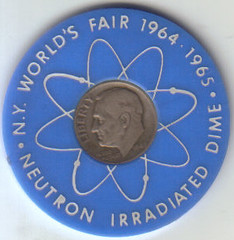
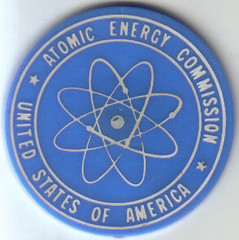
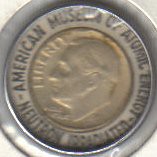 Here is a scan of my 1951 Roosevelt neutron irradiated dime by the American Museum of Atomic Energy. The reverse is blank. I purchased it from a coin dealer in February 1998 for $5.00.
Here is a scan of my 1951 Roosevelt neutron irradiated dime by the American Museum of Atomic Energy. The reverse is blank. I purchased it from a coin dealer in February 1998 for $5.00.
Besides the previously mentioned TAMS article, there was an excellent article (which is too long to copy) in Coin World on the irradiated dimes. It's entitled, "Dimes tell Oak Ridge story" by Michael E. Marotta. COIN WORLD, Monday, October 4, 1999, pp. 20 & 28. The article discusses the dimes irradiated at both the museum & the NY World's Fair and is accompanied by pictures of a number of irradiated dimes.
There was also another article on irradiated dimes, entitled "Fallout In Your Pocket." in Rochette, Edward C. 1985. The Other Side of the Coin. Frederick, CO: Renaissance House. pp. 72-73. Accompanying the article is a picture of an encapsulated "1962 "Cadmium'" dime. There is one part of the article which discusses the irradiation process at the museum.
". . . He [T.F.X. McCarthy, then information officer, Oak Ridge Institute of Nuclear Studies] assured me that only a few atoms of the dime's silver had been made radioactive during its exposure in the radiation device and that silver loses its radioactivity at such a fast rate that the dime would 'probably' fail to register on a Geiger counter by the time the visitor leaves the museum.
Making dimes radioactive was discontinued only when silver coins disappeared from circulation in the mid-1960s. When exposed, the silver in the dimes changed from Ag-109, which absorbed neutrons very easily, to AG-110, which is radioactive. The dimes, for about four minutes, were capable of emitting low-energy beta radiation. After 10 half-life periods, less than a tenth of one percent of the original activity remained and could be detected only by highly sophisticated equipment. . . . the exposed silver transformed itself into stable Cadmium-110."
Based upon the foregoing, I find it hard to believe that "If you have a Geiger counter you can confirm this! Indeed, this was done at an early Fest" as was stated in an earlier Esylum." For this to occur, that dime had to be hit with a LOT more radiation than was being used. I would guess the Geiger counter used at the Fest was picking normal background radiation and not radiation from the dime. Indeed, if you turn a Geiger counter on (as I have done in my geology classes), every now and then it will click. That is from normal background radiation.
To read the earlier E-Sylum article, see: IRRADIATED DIMES (www.coinbooks.org/esylum_v14n51a07.html)
DOLLAR COIN PRODUCTION VIRTUALLY HALTED
 The presidential dollar coin has fallen victim to Washington's cost cutting efforts.
The presidential dollar coin has fallen victim to Washington's cost cutting efforts.
The White House said Tuesday it is stopping nearly all production of the coins, which carry the likeness of every deceased president. The effort will save taxpayers $50 million a year in production and storage costs.
In 2005, Congress passed the Presidential $1 Coin Act, which mandated that the United States Mint issue four new coins each year from 2007 to 2016.
But as it turns out, there just wasn't much demand.
"Surprising, to my shock and dismay," Vice President Joe Biden said jokingly Tuesday as he announced plans to stop production.
The United States Mint had been producing between 70 and 80 million coins per deceased president. But the lack of demand has resulted in nearly 1.4 billion coins -- or 40 percent of those produced -- being returned to the Federal Reserve.
Treasury Secretary Timothy Geithner said simply: "That costs money."
The White House says the coin surplus will more than meet the demand for the coins for at least a decade. And the Mint will still be required by law to produce a small number of coins for collectors.
The announcement is part of a White House campaign to cut back on government waste.
To read the complete article, see:
White House cuts production of presidential coins
(www.boston.com/news/nation/articles/2011/12/13/white_house
_cuts_production_of_presidential_coins/)
More than 40% of the coins that are minted are returned to the government unwanted, the Treasury said. The rest apparently sit in vending machinesâ"one of the few places they are widely usedâ"or in the drawers of coin collectors.
What the coins don't do is get around much. In fact, the Mint has never had much luck with dollar coins. The Susan B. Anthony dollar (1979-1981, revived for one year in 1999) never caught on; some people said it was too close in size to the quarter. Neither did the Sacagawea Golden Dollars (2000-2008) or its successor, the Native American $1 Coin, which has the same front but a different back.
But that didn't discourage Congress. In 2005, it mandated that the Mint make $1 coins with the likenesses of the presidents, four each year between 2007 to 2016. So far, the Mint is up to James Garfield, the 20th president. Next up: Chester A. Arthur.
"And as it will shock you all, the call for Chester A. Arthur coins is not there," Mr. Biden said at a Cabinet-level meeting of a White House campaign to cut government waste.
Arthur fans needn't fret. The Mint will keep producing the presidential $1 coins on schedule, but will only make enough to meet collector demand and no longer attempt to circulate them. By law, 20% of all dollar coins produced have to be Native American coins, so production of them will be reduced too.
Whenever Mint officials were asked about this before, they basically said "Congress made us do it." So if the law tied the Treasury's hands, what changed to allow the halting of production now? I asked David Ganz, and his take on it is below. Thanks! -Editor
David Ganz writes:
On Dec. 22, 2005, Pubic Law 109-145 was enacted (31 USC 5112(n)(4)(B) of which provides that "The Secretary [of the Treasury] shall prescribe, on the basis of such factors as the Secretary determines to be appropriate, the number of $1 coins that shall be issued with each of the designs selected for each year of the period referred to...."
Evidently, the Secretary made a finding that the Mint was not making a profit on these coins (see below).
The announcement of a scaling back of the presidential dollar coin series, and a purported $50-million savings, is a canard that will only wind up costing the American taxpayer money. In the 2010 Annual Report of the Director of the Mint, the seigniorage (or profit made from coin production) is listed as follows (by denomination):
Seigniorage per $1 issued
Cent: -$0.79
Nickel -$0.85
Dime 0.43
Quarter 0.49
Half 0.68
Dollar 0.49
What this shows is that the presidential dollars have a profit of around half of the face value, on each one produced, while the cent and nickel operate at a loss. (Their accounting makes no sense, either). Under the Mint's unique system of accounting, when you replace coinage, those whose production continues shoulder more of the cost.
That is, right now every quarter that is produced costs about 15¢ (seigniorage 10¢). If the cent, nickel and dollar were eliminated, all of the cost would be borne by the dime and quarter, which might then come close to operating at a loss.
That's why the State Quarter program that I first proposed in the early 19990's ultimately made a profit for the benefit of the American people of over $5-billion (1999-2009). The more presidential dollars that are made, the more seigniorage (or profit) accrues. That is truly the economics of it.
To read the complete article, see:
The Buck Stops Here: $1 Coins to Be Curtailed
(online.wsj.com/article/SB10001424052970204
336104577096893162350800.html)
SOME IN CONGRESS CONSIDER ELIMINATING THE PAPER DOLLAR
A recent study by the Government Accountability Office said the government could save about $5.5 billion over 30 years if it phased out dollar bills, which last about three years on average, and replaced them with dollar coins, which can circulate for three decades before they become worn out.
The projected savings have prompted some House Republicans, eager to pare government spending in these austere times, to champion a changeover. While doing away with the greenback has been debated for decades, many on both sides of the issue consider the odds, while still long, to be better than ever.
As a result, coin and bill backers have begun a lively back and forth over the merits of such a remaking of the country's currency. They disagree on whether the coin would excessively weigh down consumers and complicate transactions for business owners. And they are far apart on whether the government would reap the cost savings that the accountability office predicts.
To read the complete article, see:
Hoping to Save Money for the Government, Some Seek an End to the $1 Bill
(www.nytimes.com/2011/11/06/us/some-seek-to-replace
-the-dollar-bill-with-the-dollar-coin.html)
DICK JOHNSON ON STEEL COIN LEGISLATION
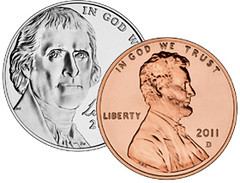 Legislation was introduced in Congress this week to make cents and nickels of plated steel planchets replacing existing compositions that are unsatisfactory. This is Band-Aid Legislation offered to cover the festering sore of low value coins costing more to manufacture than their face value. The U.S. Treasury lost $42 million last year because of the increased cost of metals -- copper and nickel -- that go into cent and nickel coin alloys.
Legislation was introduced in Congress this week to make cents and nickels of plated steel planchets replacing existing compositions that are unsatisfactory. This is Band-Aid Legislation offered to cover the festering sore of low value coins costing more to manufacture than their face value. The U.S. Treasury lost $42 million last year because of the increased cost of metals -- copper and nickel -- that go into cent and nickel coin alloys.
Rep. Steve Stivers, who introduced bills H.R. 3693 and H.R. 3694, is overlooking two important factors. Plated steel would have tremendous problems of salvaging the scrap of blanking -- and the scraping of the coins themselves later on -- plus the fact one-cent and five-cent coins are no longer viable as a coinage denomination in a present-day economy, their economic value in commerce has long since expired.
Whenever a new composition is considered for striking coins, many factors need to be considered. True, as Rep Stivers contends, steel is an American resource (much of it in his native state Ohio) but steel is a bitch to strike (die wear is greatly increased!). That can be overcome with improved coining techniques. What is a larger problem, however, is separating steel from its coated components once it is plated. This would be required for the skeleton scrap from which blanks have been produced. Also for worn, damaged, recalled coins destined to be scrapped.
That is why this writer has given high marks to the Treasury Department for their choice of present-day copper coated zinc for cent composition. This merely needs to be melted to be reformulated into high value brass. A brilliant choice!
Copper and steel do not have have such a desired alloy and would become a scrapping nightmare. (A choice of two methods exist: one by electrolysis to deplate or reverse plating to remove the copper from the steel, or by pulverizing the the entire alloy and mechanical separation by magnetism of the iron. Both choices, however, are more expensive than the lower value metals that either process would yield.)
Sorry, Rep. Stivers, plated steel coins is a dumb idea. You are creating unintended consequences. Instead, abolish both coin denominations and let's round off every transaction to the nearest 10-cent value. Now that's intelligent! And let's adopt a total approach to our entire coinage specifications, not just try to put out the fire when a recent flame (high metal costs) erupts! Would you like to read my 42-page report "Future Coins"?
Here is this week's news item: Legislation Seeks Steel Cents and Nickels (news.coinupdate.com/legislation-seeks-steel-cents-and-nickels-1117/)
And here is what I have written about this problem earlier this year: DICK JOHNSON: ALUMINIZED-STEEL NOT A VIABLE CENT ALLOY (www.coinbooks.org/esylum_v14n36a13.html)
THE BOOK BAZARRE
KLAN KREED COIN

I JUST LOVE THIS TOKEN! It makes me want to go out and form my own secret society so I can issue a token just like this. Each group of letters has its own secret meaning and indeed, some of them have double meanings.
Fortunately, we don't have to join the Klan to dope out what all of this means as we have Dale Birdsell to help us out. The letters N S S A around the border on the outside have a meaning evident to every veteran Klan Kollector: Non Silba Sed Anthar - Not for self but for others. (This is the same motto, only in Greek, that is also used by one of the oldest Jewish college fraternities, a curious fact which I never fail to inform my old college fraternity brothers of when they greet me with our secret words and handshake!)
Birdsell describes the six pointed star as "the Bethlehem Star" and says that its meaning speaks for itself. (Funny, I always thought that this was the Star of David, which is used by Jews much like Christians use the sign of the cross.) In any event, the letters LSS and KAP are said by Birdsell to stand for Love, Sacrifice and Service, and for Keep America Protestant. The white enamel, of course, stands for White Supremacy.
The reverse is much more intricate and meaningful. Each letter and group of letters has two or more meanings. O T P P, for example, is said by Birdsell to mean "On Top Pikes Peak, P___ On The P___." I take this last phrase to be, "Piss on the Pope." According to Birdsell, the outside letters (read counter clockwise starting with the lower right "P") mean "Protestants Teach Other Protestants."
What they teach is indicated within the circle by the letters contained within the Star of David (Oooops - The Bethlehem Star.) 1S/1L/1F stands for "One School, One Language, One Flag." Individually, the SLF letters represented: Sincerity/ Friendship/Love. The letters in the central circle mean Law & Order and the American Bible.
The late David Dreyfuss always loved to purchase items for which there was an interesting story. No matter what he paid, he always felt he got his money's worth out of such pieces by the pleasure he obtained from telling the uninitiated something interesting that was not evident from just looking at the item. Viewed this way, this token should be priced at several thousand dollars! Combined with its more Kommon Komrade, the "Dago Pope in Rome" token, it tells volumes about the Klan; its love of secrecy and the cryptic; its ultra-nationalism and its pseudo-religiosity. One doesn't have to be in sympathy with the views of the Klan in order to be able to appreciate what a truly fascinating piece of Americana this is.
KOLBE-FANNING 2012 NEW YORK SALE LOTS: NEWLIN, PERKINS
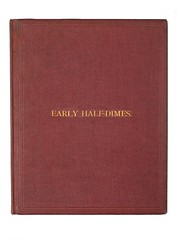 317 Newlin, Harold P. A CLASSIFICATION OF THE EARLY HALF-DIMES OF THE UNITED STATES. WITH A FEW REMARKS ON THEIR TYPES, VARIETIES, RARITY, ETC., ETC. First edition. Philadelphia: John W. Haseltine, 1883. 8vo [25 by 20 cm], original crimson cloth, gilt; triple blind fillets on both sides; beveled edges; chocolate endpapers. 24 pages; 2 fine facing heliotype plates of coins with an intersecting protective tissue guard. A few light scuffs to back cover, else fine. (900.00)
317 Newlin, Harold P. A CLASSIFICATION OF THE EARLY HALF-DIMES OF THE UNITED STATES. WITH A FEW REMARKS ON THEIR TYPES, VARIETIES, RARITY, ETC., ETC. First edition. Philadelphia: John W. Haseltine, 1883. 8vo [25 by 20 cm], original crimson cloth, gilt; triple blind fillets on both sides; beveled edges; chocolate endpapers. 24 pages; 2 fine facing heliotype plates of coins with an intersecting protective tissue guard. A few light scuffs to back cover, else fine. (900.00)
One of only 40 copies issued with plates, of an entire edition of 100. The plates were originally prepared to accompany the April 10, 1883 auction of Newlin's collection but none were actually issued with the sale catalogue. A very nice example of one of the rarities of American numismatic literature. Clain-Stefanelli 12327. Davis 771. Ex David Davis library.

George Perkins's Detailed Notebooks Cataloguing His Collection of Connecticut Coppers 318 [Perkins, George C.]. NOTEBOOKS ITEMIZING THE GEORGE C. PERKINS COLLECTION OF CONNECTICUT COPPERS. Undated. Five small [22.5 by 17 cm] blue cloth three-ring binders, some with tabbed dividers, containing approximately 750 leaves of detailed notes and descriptions by George C. Perkins, comprised of typewritten forms filled out in type and by hand, and consisting of a detailed record of the Connecticut coppers in his collection. A number of additional items included [see comments]. Near fine. (4000.00)
Unique and of extraordinary importance. The collection of Connecticut copper coins formed by George C. Perkins was one of the finest ever assembled, with the front-line collection including 302 different die varieties. Three of these notebooks were originally included in the January 12â"13, 2000 Stack's auction of Perkins's collection (lot 535), but were withdrawn from that sale by Perkins, who decided to keep them. Those three recorded his mainline collection: they are present here as well as two volumes recording Perkins's duplicates.
Rediscovered in late 2010 in his estate, they form a remarkable record of this important collection. The notebooks take the form of typewritten forms devised by Perkins on which he recordedâ"in astonishing detailâ"his beloved Connecticuts. The forms, often filled out in type, but at times entirely by hand, record the date, die variety and grade of each coin, along with its weight, diameter, thickness, die axis, provenance, date of acquisition and source, and much other information.
Speculations on mint and die cutter are included, and most coins are compared to those in the 1975 Pine Tree EAC sale. The forms are further annotated in ink, with many interesting observations on die states, cracks, the condition census and so forth. Each coin is meticulously described, often with full paragraphs written about the obverse and reverse. In addition, many coin envelopes are attached to the pages, as are a few photographs, photocopied letters, photocopied catalogue descriptions or photos, and other items (including a âColonial American Coin Clubâ certificate signed by Walter Breen and Don Taxay). Adding machine tape, recording the cost of the collection, is also laid in.
These notebooks represent countless hours of labor and are a testament to the work that this legendary collector dedicated to forming a truly outstanding collection. A unique and fascinating record.
To view the complete catalog, see: 2012 New York Public Auction (www.numislit.com/numislit/images/pdfcatalogs/3_catalog.pdf)
THE 1766 PATTERN ROUBLE OF CATHERINE II
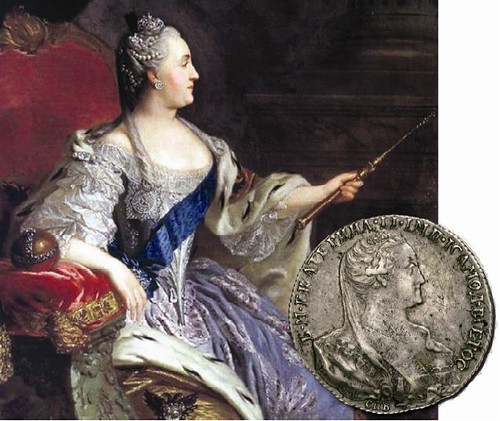
An entirely new numismatic discovery is set to cause a stir at the 2012 New York International Numismatic Convention. Lot 2092, a 1766 pattern Rouble depicting the bust of Catherine II, has for the first time been linked to a monumental official painting of the Tsarina by renowned artist Fedor Rokotov (pictured below with the 1766 Rouble). The lot is one of the greatest rarities in the Russian series and it is estimated that this piece will sell for around US$1,000,000.
In 1766 it was decided that a new medallic portrait of the Empress was required and lot 2092 is the pattern created by an unknown die engraver. Clearly officially commissioned (as indicated by the pattern's mintmark and the master's initials) the engraver would have been given one or more official portraits of Catherine to use as a model. However, the bust most resembles the 1763 painting of Catherine by Fyodor Rokotov.
The coin collection of the Grand Duke Georgii Mikhailovich, one of the finest Russian collections ever assembled, lacked an example. The Grand Duke himself knew of only two specimens, one in the Hermitage and the other in a private collection. In the Renaissance Sale of August 2000 an example was sold by public auction. The specimen offered here, a better example than the other two, brings the count up to three known pieces. It is unclear however whether the piece offered in the Renaissance Sale or the piece offered here is the âprivate collection specimen' referred to by Grand Duke Mikhailovich.
This coin will be sold as part of The New York Sale XXVII-XXIX, alongside the spectacular Prospero Collection of ancient Greek coins, at the Waldorf Astoria Hotel in January 2012.
For more information visit: www.baldwin.co.uk

VIKING COIN FIND IN LANCASHIRE, ENGLAND

A hoard of silver found by a metal detector has provided intriguing new clues to a previously unknown Viking king, the British Museum announced on Wednesday.
Found some 16 inches beneath the surface of a field in Silverdale, a village in north Lancashire, UK, the hoard materialized as Darren Webster, a 39-year-old stonemason, lifted a lead box signalled by his detector.
A shower of 201 pieces of silver revealed an abundance of arm-rings, brooch fragments, ingots and coins.
"I had a very good idea what it was. The coins, the bracelets, I knew it was possibly Viking, more than likely Viking," Webster told the Lancashire Evening Post.
Indeed, the treasure, possibly buried by a Viking warrior before he went into battle, includes coins which evoke Viking kings such as Alfred the Great, who reigned from 871 to 899. At that time, the Vikings were fighting the Anglo-Saxons to keep control of the North of England.
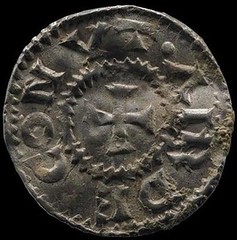 "Among the many stand-out objects is a coin type none of us had seen before," said Ian Richardson, treasure registrar at the British Museum's Portable Antiquities and Treasure department.
"Among the many stand-out objects is a coin type none of us had seen before," said Ian Richardson, treasure registrar at the British Museum's Portable Antiquities and Treasure department.
On one side, the coin bears an inscription in the shape of a cross which reads DNS (Dominus) REX (many Vikings had converted to Christianity within a generation of settling in Britain).
More intriguingly, the inscription on the other side reads AIRDECONUT -- "an attempt to represent the Scandinavian name Harthacnut," said Richardson.
To read the complete article, see: FOUND COINS MAY UNVEIL A LOST VIKING (news.discovery.com/history/silver-viking-king-111215.html)
DAYTONA COUNCILMAN SPENDS REAL FAKE CASH
The "phony cash" that landed former City Councilman Hank Smith in jail last month may not have been counterfeit after all, police said.
The State Attorney's Office said Monday it declined to file formal charges against Smith after Daytona Beach Shores investigators determined "the bills in question are not counterfeit."
The 50-year-old Smith had been charged with uttering forged bills and possession of more than 10 counterfeit bills on Nov. 30. Police said Smith entered a liquor store and a gas station on two separate days and offered dollar bills as payment for rum and cigarettes.
Monday afternoon, Daytona Beach Shores Sgt. Mike Fowler said the cash was sent to the U.S. Department of the Treasury for investigation and "the Department of Treasury couldn't determine it (the money) was counterfeit."
The bills Smith used came from a sheet of 32 one-dollar bills that were framed and sold as a novelty at a jewelry store at the Daytona Flea and Farmer's Market. Smith said he purchased the framed bills in 1985 for almost $200 and hung the item in the TV room of his residence.
"I always thought the money was real," Smith said from his home on Monday afternoon. "We spent it in our own town. I would never (spend counterfeit money) in my own town."
The former councilman said the fancy frame that contained the bills included the words "U.S. Department of the Treasury" on it, so he had no reason to doubt that the cash was legal tender.
When a fire ravaged most of his house some years ago, however, Smith placed the framed money and some other valuables in a shed. Recently, when he retrieved the frame from the shed, Smith said he told his wife: "Let's spend it."
But, according to Fowler, Smith thought the cash was counterfeit.
"The clerks (at the stores) thought it was fake, the police thought it was fake and Hank Smith thought it was fake," Fowler said. "His intent was to pass counterfeit bills."
Smith, who resigned from his City Council seat in August, denied saying the money was fake and that he intended to go out and spend counterfeit cash.
"If I were to be making counterfeit bills, do you think I would be making one-dollar bills?" he asked. "I would never do that."
To read the complete article, see:
No charges for former Shores councilman in fake cash case
(www.news-journalonline.com/news/local/east-volusia/2011/12/13/
no-charges-for-former-shores-councilman-in-fake-cash-case.html)
MORE ON THE OCCUPY MOVEMENT DOLLAR BILL
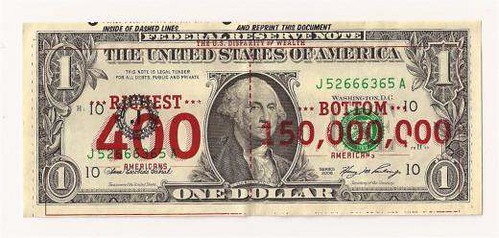
Howard A. Daniel III writes:
I would not assign "Chopmarks" to the "Occupy" overprints mentioned in a recent issue of The E-Sylum. "Chopmarks" are a method of authenticating money and the "Occupy" overprints are pure propaganda.
I was in the "intelligence" field for a couple of decades and propaganda leaflets are a part of it. Herb Friedman, a retired US Army Sergeant Major, is a specialist in this area and has a website at www.psywar.org, where you can see many different leaflets and other propaganda pieces. The overstamped dollars are not the first time money or copies of money has been used to grab someone's attention to a message. You can also find some of these in a catalog by Fred Schwan and Joe Boling titled World War II Remembered.
The current overstamped dollars are an attempt to spread class warfare in the United States. It is one of the bedrock and fundamental methods of spreading the Socialist and Communist Party platforms. I have seen these parties use this tactic in almost every country in the world. And now it is bigtime in the United States. It is not humorous to me but sad to see so many people duped by their messages, and want to tear down the fabric of our country. The "Occupy" people and their supporters are dangerous and should be taken very seriously about their wanting to fundamentally change the United States.
When and if you donate one or more of the "Occupy" dollars to a numismatic collection, please correctly identify it as a propaganda piece from the Socialists and Communists.
I prefer to stick to numismatics and keep politics out of The E-Sylum, but since Howard's primary point was about how to classify this numismatic item, I published his note in full. But let's not go further down this path.
To return to numismatics, I was surprised no one commented on the text at the top of the image. It says something like "INSIDE OF DOTTED LINE... AND REPRINT THIS DOCUMENT". Was this printed on a flyer or in a newspaper? The writer of the article said he got the note in change. If someone printed it out and spent it, that's uttering a counterfeit. And the printer is a counterfeiter. Can anyone verify their source? This possibility brings to mind the Confederate notes of Samuel Upham. He printed them in the North as "souvenirs" of the Rebellion, but buyers happily smuggled them south and spent them.
-Editor
To read the earlier E-Sylum article, see: AN OCCUPY MOVEMENT DOLLAR BILL (www.coinbooks.org/esylum_v14n51a19.html)
THE CIA BAY OF PIGS COUNTERFEITS
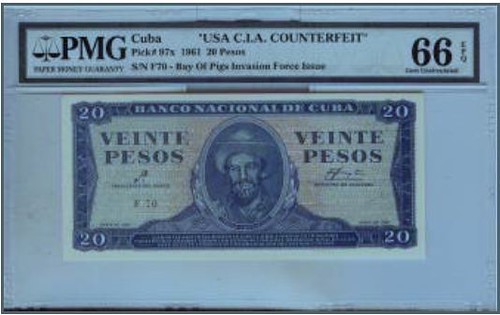
Since the invasion of Cuba at the Bay of Pigs by CIA backed Cubans was a covert operation, supposed "locals", flashing gold or foreign currency was deemed too noticeable. With relations non-existent with the Castro regime and not wanting to alert Castro, fake notes were printed for the invasion force of about 1200. These all bear series F69 and F70. All this secrecy was of course for naught, with Castro waiting for the invasion. The forged note, a 20 Peso note, depicts Camilo Cienfuegos on the front and troops in the jungle on reverse. Cienfuegos died in a mysterious plane crash soon after the Cuban Revolution.
Friedman writes:
I hesitate to mention these banknotes as part of a Cold War operation because they were allegedly to be used in the Bay of Pigs invasion. However, one would assume that the notes were printed well before the invasion and because they were such good imitations were probably used before and after the invasion in an attempt to harm the Cuban economy.
It is alleged that the United States CIA forged Cuban 20 pesos Banco Nacional de Cuba notes of 1961 for the Bay of Pigs invasion. It is also alleged that each soldier in the invasion force was issued 100 of the forgeries. However, a news item in Bank Note Reporter of June 1987, entitled "Cuban counterfeit deleted from Pick" reports that Cuban sources claimed that these items were privately produced, and were not made by the CIA. We tend to doubt the veracity of this report, delayed 25 years. The forgery is mentioned in Bay of Pigs, Peter Wyden, Simon and Schuster, New York, 1979. The forgeries are rather easy to spot because of their serial numbers or lack of same. Four types are known
To read the complete article (scroll down to Cuba), see: COLD WAR AND INSURGENCY PROPAGANDA BANKNOTES (www.psywar.org/coldwarcurrency.php)
U.S. HALF DIME CIRCULATION IN CUBA
After the Spanish American War, during the American occupation of the Island, the Americans who traveled into the interior were surprised to receive silver American half dimes in their change. These coins, minted from 1795 to 1873, were no longer in circulation in the United States, but were used in Cuba and other West Indian Islands that had extreme necessities of small change, such as 2 ½ centimos. All these coins were punched and had no use in the U.S., so apparently some enterprising person brought them to the island during the coinage scarcity which affected the West Indies during the nineteenth century. It is unknown how they were entered into the money exchange market, nor how many of these little coins were exported to Cuba, but recent reports are that you can still find some there, however, in very bad shape and not in your change, but in the hands of collectors and individuals. These coins were used mostly in the towns of the interior and even after the 1915/16 Cuban national coinage was issued. US collectors are aware of the rarity of the 1794 (dated) to 1805 half dimes, whereas the 1829-1873 issues could have been feasible for the purpose of this coin shortage.
BRASHER DOUBLOON SELLS TO HEDGE FUND
 It seems the 1 percent isn't content with merely controlling 40 percent of the nation's wealth. It also now has the nation's most famous coin.
It seems the 1 percent isn't content with merely controlling 40 percent of the nation's wealth. It also now has the nation's most famous coin.
At least that's how it looked this week when a San Francisco coin dealer revealed that the 1787 gold Brasher Doubloon, probably the rarest of all American coins, has been sold to - you guessed it - a Wall Street investment firm.
The coin was worth $15 when George Washington's neighbor Ephraim Brasher minted it. The firm that bought it this month paid $7.4 million.
That's just under the record $7.6 million paid in 2002 at auction for a 1933 $20 gold Double Eagle.
"Who else could afford this but someone in the 1 percent?" said Don Kagin, the rare-coin dealer who sold the Brasher Doubloon to an intermediary at the beginning of December for more than $6 million in cash and other rare coins. That intermediary quickly sold it to a broker in New Orleans, who then sold it to the Wall Street firm.
Nobody involved is revealing the identity of the firm.
The front features a mountain with a sun shining over it, and on the back is an eagle with a shield on its breast. This was the first coin made by Brasher, who stamped his initials, "EB," in the middle of the shield.
Subsequent Brasher Doubloons bore his initials on the eagle's wing, and there are six of those in museums and private collections. Their success in the field prompted Treasury Secretary Alexander Hamilton to hire Brasher as official currency assayer.
"The Brasher Doubloon," a 1947 film starring George Montgomery and based on a Raymond Chandler novel, propelled the coin's reputation into popular lore. In it, private eye Philip Marlowe is hired by a rich widow to find the piece after it is stolen.
Kagin hopes to entice the new owner to lend the doubloon to a coin museum he and others want to establish in the next few years at the old San Francisco Mint building at Fifth and Mission streets.
He has actually owned the Brasher piece twice - buying it first in the late 1980s for less than $1 million, selling it and then buying it again with a partner in 2005 for $2.9 million. Both times he took it on tours to show off to adoring fans at coin shows all over the country.
I'm getting old enough to have seen this movie before - coins go up in value, beating Wall Street; Wall Street firms jump on the bandwagon; Wall street firms (and their clients) get royally screwed. Is this a sign of the top of the market for high-end coins? When investors are buying and selling to one another while real collectors sit on their hands at the auction, something's gotta give sooner or later. -Editor
HOW TO BECOME A BIBLIOMANIAC
Kay Olson Freeman writes:
This was sent to me from a Providence, RI newspaper by my friend Sam Hough. The rticle is about book collecting, and has some amusing stories.
Sam Hough is a bookseller and his living room is a wonderland of books and relic-like gewgaws that people of that profession are inclined to accrue. True, there are owls about the place, in prints, as figurines and by other representation but that is not why he calls his business The Owl at the Bridge.
âObviously, we like owls but the name came from being near the Pawtuxet Bridge and the image of an owl at the bridge appealed to me,â said Hough (pronounced âhuffâ).
Although he once did have a small space on Broad Street when he started selling books in the 1980s, the brave new world of inflated real estate costs and diminished foot traffic made maintaining the space impractical.
âI do keep some of my stock here in the house but I also have 2,500 square feet of storage on Wellington Avenue,â he said. âOur book shop was always much too small for the space we needed.â
Like most booksellers in the digital age, Hough has adapted to the world of online bookselling. In fact, very few used bookstores could sustain themselves by walk-in sales alone. Catalogs and mail order have been a major part of the rare book business for centuries but Goodspeed's, The Brattle Book Shop and other small stores in Boston made good money catering to leisurely walk-ins or the lunching masses that haunted the 25 and 50 cent tables everyday. Now, if Sam Hough wants to get his hands on a good book, he has to go to a public or private library. He won't find the bookstores of his youth in Philadelphia, or his salad days of acquiring books for college libraries. There are no easy fixes for a bibliomaniac these days. Everyone is waiting for the mail, or, as some would have it, the âsnail mail.â We must wait, anxiously and tensely, for our junk to come from the Post Office or UPS.
These are bad times for book addicts.
In his 1944 article, âBook Row,â in the Saturday Evening Post, Don Samson gives a brief history of a bibliomaniac that haunted the area.
âA shoe clerk from Brooklyn wandered into one of the secondhand bookshops on Book Row. He had never bought a book in his life, but picking up a musty volume, he liked the feel of it and bought it. The more he handled it, the more he liked it. He began buying booksâŚFinally, his wife couldn't take a bath because the tub was full of booksâŚand threatened to go home to mother unless he got rid of them. He did. But within two weeks he was buying books againâŚShe went home to mother.â
To read the complete article, see: How to become a bibliomaniac (warwickonline.com/stories/How-to-become-a-bibliomaniac,65291)
THE LIBRARY THAT LOOKS LIKE A BOOKSHELF
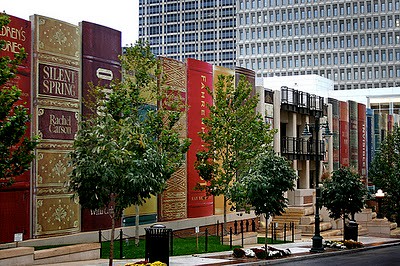
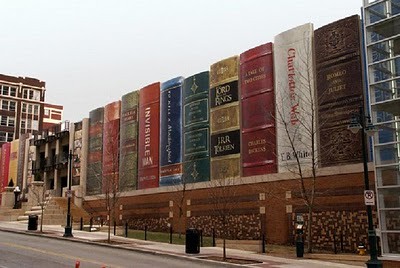
FEATURED WEB PAGE: WHICH CHARPENTIER MADE THAT MEDAL?
This week's Featured Web Page by Emmanuel Van Dorpe lays out evidence distinguishing two medallists whose work is often misattributed to the other: Maurice Charpentier-Mio and Alexandre Charpentier. His argument centers on style, chronology, and the artists' signatures (or monograms).
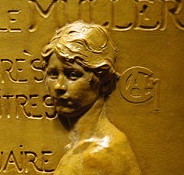
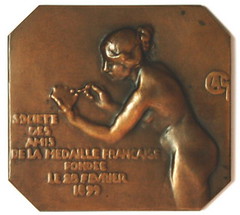
Monograms of Alexandre-Louis-Marie Charpentier (ALM in a C)
users.telenet.be/emanuel.vandorpe/
artmedal/lapeinture.htm

